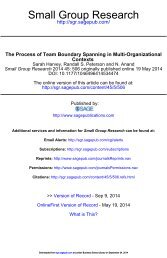A Dynamic Perspective on Diverse Teams: Moving From The Dual Process Model to A Dynamic Coordination-Based Model of Diverse Team Performance - Kannan Srikanth, Sarah Harvey & Randall Peterson
The existing literature on diverse teams suggests that diversity is both helpful to teams in making more information available and encouraging creativity and damaging to teams in reducing cohesion and information sharing. Thus the extant literature suggests that diversity within teams is a double-edged sword that leads to both positive and negative effects simultaneously.
The existing literature on diverse teams suggests that diversity is both helpful to teams in making more information available and encouraging creativity and
damaging to teams in reducing cohesion and information sharing. Thus the
extant literature suggests that diversity within teams is a double-edged sword
that leads to both positive and negative effects simultaneously.
Create successful ePaper yourself
Turn your PDF publications into a flip-book with our unique Google optimized e-Paper software.
16 † <strong>The</strong> Academy <strong>of</strong> Management Annals<br />
Downloaded by [L<strong>on</strong>d<strong>on</strong> Business School Library], [<strong>Randall</strong> Peters<strong>on</strong>] at 06:11 31 January 2016<br />
effects, group process effects, and performance. <strong>The</strong> first approach is <strong>to</strong> focus <strong>on</strong><br />
<strong>on</strong>ly <strong>on</strong>e edge <strong>of</strong> the sword by specifying links between type <strong>of</strong> diversity and its<br />
predicted effects. For example, Bantel and Jacks<strong>on</strong> (1989) focused <strong>on</strong> the<br />
relati<strong>on</strong>ship between functi<strong>on</strong>al and educati<strong>on</strong>al diversity and innovati<strong>on</strong>,<br />
which is expected <strong>to</strong> be mediated by informati<strong>on</strong>al effects, whereas Lau and<br />
Murnighan’s (1998) theory focused <strong>on</strong> faultlines based <strong>on</strong> demographic characteristics<br />
and the attendant c<strong>on</strong>sequences for group processes.<br />
A sec<strong>on</strong>d approach is <strong>to</strong> c<strong>on</strong>sider modera<strong>to</strong>rs <strong>of</strong> the diversity–performance<br />
relati<strong>on</strong>ship that may operate <strong>on</strong> <strong>on</strong>e or both edges <strong>of</strong> the sword. Often these<br />
studies measure <strong>on</strong>ly a final performance outcome variable and the modera<strong>to</strong>r,<br />
without examining the hypothesized mediating processes <strong>of</strong> informati<strong>on</strong> elaborati<strong>on</strong><br />
or social categorizati<strong>on</strong>. For example, Nishii and Mayer (2009) dem<strong>on</strong>strated<br />
that the positive effect <strong>of</strong> demographic diversity <strong>on</strong> a team’s turnover is<br />
moderated by leader-member exchange, and Jehn and Bezrukova (2004) found<br />
that functi<strong>on</strong>al diversity had a positive effect <strong>on</strong> performance in organizati<strong>on</strong>s<br />
with a people-oriented culture. Similarly, theories that draw <strong>on</strong> c<strong>on</strong>flict <strong>to</strong><br />
explain the effects <strong>of</strong> diversity in teams <strong>of</strong>ten provide models that include<br />
both task c<strong>on</strong>flict as the source <strong>of</strong> informati<strong>on</strong>al effects and relati<strong>on</strong>ship c<strong>on</strong>flict<br />
as the source <strong>of</strong> group process losses (Choi & Sy, 2010; Pelled et al., 1999).<br />
However, those studies measure the c<strong>on</strong>sequences (i.e. different kinds <strong>of</strong> c<strong>on</strong>flict),<br />
rather than their causes (i.e. informati<strong>on</strong> elaborati<strong>on</strong> or social<br />
categorizati<strong>on</strong>).<br />
It is noteworthy that very few studies actually measure the media<strong>to</strong>rs that<br />
are theorized <strong>to</strong> underlie the effects <strong>of</strong> diversity <strong>on</strong> performance. A few<br />
studies measure informati<strong>on</strong> elaborati<strong>on</strong> as the mediating variable for the positive<br />
effects <strong>of</strong> diversity. For example, Van der Vegt and Bunders<strong>on</strong> (2005)<br />
include learning and Kearney, Gebert, and Voelpel (2009) include informati<strong>on</strong><br />
elaborati<strong>on</strong> as media<strong>to</strong>rs <strong>of</strong> the team diversity–performance relati<strong>on</strong>ship. In<br />
c<strong>on</strong>trast, the mechanisms through which negative group processes are expected<br />
<strong>to</strong> occur—social identity and social categorizati<strong>on</strong>—are rarely explicitly tested.<br />
When negative interpers<strong>on</strong>al group outcomes, like relati<strong>on</strong>ship c<strong>on</strong>flict,<br />
increased turnover, or low trust are found, they are theoretically linked <strong>to</strong><br />
those mechanisms rather than explicitly measured. Similarly, when modera<strong>to</strong>rs<br />
such as group identificati<strong>on</strong> are supported, they are theoretically expected <strong>to</strong><br />
operate by enabling group members <strong>to</strong> overcome identificati<strong>on</strong> with subgroups<br />
without actually measuring identificati<strong>on</strong>. For example, a low level <strong>of</strong><br />
affective commitment <strong>to</strong>ward the group (e.g. Kearney et al., 2009; Van der<br />
Vegt & Bunders<strong>on</strong>, 2005) is assumed <strong>to</strong> indicate that social categorizati<strong>on</strong> processes<br />
are in operati<strong>on</strong>, but these processes themselves are not measured.<br />
<strong>The</strong> problem with these empirical approaches is that fac<strong>to</strong>rs other than categorizati<strong>on</strong><br />
and identificati<strong>on</strong> processes could be intervening between diversity<br />
and group process outcomes such as relati<strong>on</strong>ship c<strong>on</strong>flict or group identificati<strong>on</strong>.<br />
This possibility is especially important in the studies in this category,
















